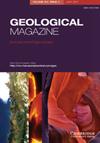伊朗库尔德斯坦省Qorveh-Bijar火山带上第三纪—第四纪碱性玄武岩的岩石成因及地球化学特征
IF 2
3区 地球科学
Q3 GEOSCIENCES, MULTIDISCIPLINARY
引用次数: 0
摘要
在Qorveh和Bijar之间露头的上新世-第四纪火山岩是伊朗北部碰撞后板块内火山活动的一部分。这些基性碱性岩石构成了Sanandaj-Sirjan (Hamedan-Tabriz)带北部的一部分。平衡斜辉石-全岩对的测温结果显示压力和温度分别为4-6(±1.8)kbar和1182-1213(±27)°C;橄榄石-整个岩石(熔体)平衡测温得到结晶温度为1212-1264(±27)°C。现场关系,包括辉石质捕虏体的存在,以及地球化学证据(例如,与橄榄岩来源的熔岩相比,高FeO/MnO和低CaO)表明所研究岩石的辉石质地幔来源。Ce/Pb、Ba/La、87Sr/86Sr等微量元素和同位素比值的变化表明,该辉石岩地幔源是俯冲新特提斯板块熔融沉积物与周围橄榄岩岩石圈地幔相互作用形成的。由此形成的交代岩石圈比橄榄岩地幔密度更大,粘度更低,构造扰动可使其落入地幔深处。随着温度的升高,下降的富含挥发物的物质开始熔化。稀土元素(REE)丰度模拟表明,下降辉石岩< 1%的部分熔融可能形成了库尔维—比贾尔上第三纪—第四纪碱性玄武质岩浆。库尔维—比贾尔火山带岩石圈沉降的地球化学证据,以及由此导致的滴岩浆作用,得到了地震研究结果的支持,表明研究区域下方的岩石圈变薄。本文章由计算机程序翻译,如有差异,请以英文原文为准。
Petrogenesis and geochemical characteristics of Plio-Quaternary alkali basalts from the Qorveh–Bijar volcanic belt, Kurdistan Province, NW Iran
Abstract The Pliocene–Quaternary volcanic rocks which outcrop between Qorveh and Bijar are part of post-collisional within-plate volcanic activity in northern Iran. These mafic alkaline rocks form part of the northern arm of the Sanandaj–Sirjan (Hamedan–Tabriz) zone. Thermobarometry on equilibrium clinopyroxene – whole-rock pairs yields pressures and temperatures of 4–6 (±1.8) kbar and 1182–1213 (±27) °C, respectively; olivine – whole-rock (melt) equilibrium thermometry yields crystallization temperatures of 1212–1264 (±27) °C. Field relationships, including the presence of pyroxenitic xenoliths, and geochemical evidence (e.g. high FeO/MnO, and low CaO compared to lavas derived from peridotite sources) suggest a pyroxenitic mantle source for the studied rocks. Variation of trace elements and isotopic ratios (i.e. Ce/Pb, Ba/La, 87Sr/86Sr) indicate that this pyroxenite mantle source was generated by interaction between melted sediments of the subducted Neo-Tethys slab with ambient peridotitic lithospheric mantle. The resulting metasomatized lithosphere is denser and has a lower viscosity than the peridotitic mantle, and tectonic disturbance can cause it to fall into the depths of the mantle. The descending volatile-rich material starts to melt with increasing temperature. Modelling of rare earth element (REE) abundances suggests that <1 % partial melting of the descending pyroxenite could create the Plio-Quaternary alkali basaltic magma of the Qorveh–Bijar. The geochemical evidence for lithospheric foundering, and hence drip magmatism, in the Qorveh–Bijar volcanic belt is supported by seismographic studies indicating thinned lithosphere beneath the study area.
求助全文
通过发布文献求助,成功后即可免费获取论文全文。
去求助
来源期刊

Geological Magazine
地学-地球科学综合
CiteScore
4.70
自引率
0.00%
发文量
111
审稿时长
3 months
期刊介绍:
Geological Magazine, established in 1864, is one of the oldest and best-known periodicals in earth sciences. It publishes original scientific papers covering the complete spectrum of geological topics, with high quality illustrations. Its worldwide circulation and high production values, combined with Rapid Communications and Book Review sections keep the journal at the forefront of the field.
This journal is included in the Cambridge Journals open access initiative, Cambridge Open Option.
 求助内容:
求助内容: 应助结果提醒方式:
应助结果提醒方式:


